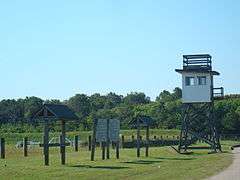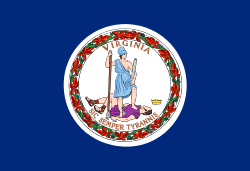Camp Pendleton (Virginia)
|
Camp Pendleton-State Military Reservation Historic District | |
|
Rifle range tower at Camp Pendleton | |
  | |
| Location | Roughly bounded by General Booth Blvd., S. Birdneck Rd., and the Atlantic Ocean, Virginia Beach, Virginia |
|---|---|
| Coordinates | 36°48′54″N 75°58′58″W / 36.81500°N 75.98278°WCoordinates: 36°48′54″N 75°58′58″W / 36.81500°N 75.98278°W |
| Area | 328 acres (133 ha) |
| Built | 1911 |
| Architect | LaPrade, W.W.; Hartman, Col. Charles D. |
| Architectural style | Bungalow/craftsman, Other, World War I & II Buildings |
| NRHP Reference # | 04000852[1] |
| VLR # | 134-0413 |
| Significant dates | |
| Added to NRHP | September 26, 2005[1] |
| Designated VLR | June 16, 2004[2] |
Camp Pendleton is a 325-acre (1.32 km2) state military reservation in Virginia Beach, Virginia, named after Brigadier General William N. Pendleton, who served as Robert E. Lee's chief of artillery during the Civil War. It lies on the Atlantic coast slightly east of Naval Air Station Oceana.
History
The facility was laid out in 1911, with construction beginning in 1912,[3] as the State Rifle Range for the use of the state militia. Between 1922 and 1942, it was named after the then serving Governor of Virginia, being firstly named Camp Trinkle (1922–1926), then Camp Byrd (1926–1930), Camp Pollard (1930–1934), Camp Peery (1934–1938), and Camp Price (1938–1942).[4] During both World Wars, the base was federalized. In World War I it was used by the U.S. Navy for coastal artillery training and during World War II it was controlled by U.S. Army, who first applied the name Camp Pendleton.[5]
National Register of Historic Places
The Camp Pendleton-State Military Reservation Historic District was designated a historic district and listed on the National Register of Historic Places on September 26, 2005. The camp initially was about 400 acres (160 ha) in size. The original 1912 construction mostly related to the rifle range, but most of those buildings were demolished prior to World War II. A second major construction phase began in 1919, during which the U.S. Navy focused on improvements to the rifle range. Those buildings have also been demolished, but the layout of both the first and second phase remains. The third and final phase of construction was the responsibility of the U.S. Army during World War II; most of the camp's remaining buildings date from that phase. At the time it was listed on the National Register, Camp Pendleton had 108 buildings in a condition good enough to qualify them as contributing properties.[3]
Current use
The operation and maintenance of Camp Pendleton is funded primarily by the federal government through the National Guard Bureau, and its primary purpose is the training of personnel and organizations of the Virginia National Guard, as well as other states' National Guard units and components of the U.S. Armed Forces. When the facilities are not used by military organizations, state and local civilian agencies also conduct training at the site. Its facilities include a small arms range, helicopter landing strip, classrooms, barracks, dining halls, maintenance garages, training fields, and a chapel. Other tenants include the Military Sealift Command, whose facilities are leased to the federal government by the State of Virginia, and the 203rd RED HORSE Air National Guard.[6] On March 3, 2001 the 18 members of the 203rd RED HORSE and 2 Florida Air Guardsmen died in a plane crash over Georgia. It is considered the worst peacetime Air Guard crash ever and the worst National Guard loss of life in Virginia since World War II.[7]
In 1991 the United States Department of Defense began the Youth Challenge Program.[8] The Virginia implementation of that program is the Commonwealth Challenge (or Commonwealth ChalleNGe), a program with a military structure operated by the Virginia National Guard on Camp Pendleton for at risk 16- to 18-year-olds. It focuses on developing "values, skills, education and self-discipline".[9] Youths come from all parts of Virginia. The Camp Pendleton program opened in September 1994 (some cite July 1994), is 5 1/2 months long, and offers a GED program. There are three phases: 2 weeks of indoctrination, 20 weeks of the core program, and a 12-month post-graduation program. Community service is part of the program. Classes start each January and June.[9] The only cost to the participant is personal items; tuition, room, and board are provided. So far 30 classes and over 3000 cadets have graduated.[8] In 2010 Virginia almost removed funding for the program but it was restored by the governor.[10]
Since shortly after World War II a 2,000 square feet (190 m2) home on the camp has served as a vacation spot for the presiding governor of Virginia. The architecture of this home is in the same style as the rest of the camp. It has vinyl siding. The "cottage" was originally built in 1915 and initially served as the commanding officer's residence.[11] Since the summer of 2004, the United States Naval Sea Cadet Corps has conducted summer and winter boot camps at Camp Pendleton.[12]
Future
When the facility was created it was in a relatively remote, sparsely populated area, but since then, the City of Virginia Beach has grown and developed around it, leading to concerns over safety issues. Over time hundreds of acres of land belonging to the camp have been sold to the city of Virginia Beach.[11][13] The role of Camp Pendleton is also changing, as more National Guard training takes place at the much larger Fort Pickett, lessening the importance of Camp Pendleton.[5] This has led to repeated requests by the City authorities to convert it to other uses, including complete or partial conversion to a state park.[6] The findings of a report completed at the behest of the Virginia General Assembly on November 22, 1998 were that it was not feasible at that time to convert Camp Pendleton to a state park because of the demands of long-term planning, coordination with the federal government, and environmental reclamation.[14]
See also
References
- 1 2 National Park Service (July 9, 2010). "National Register Information System". National Register of Historic Places. National Park Service.
- ↑ "Virginia Landmarks Register". Virginia Department of Historic Resources. Retrieved 19 March 2013.
- 1 2 "Camp Pendleton/State Military Reservation Historic District" (PDF). United States Department of the Interior, National Park Service. August 17, 2005. Retrieved June 12, 2012.
- ↑ "A Brief History of Camp Pendleton". northamericanforts.com. 2009. Retrieved May 25, 2014.
- 1 2 "Camp Pendleton". Virginia Places.org. 2010. Retrieved March 2, 2011.
- 1 2 "Camp Pendleton State Military Reservation". Global Security. 2011. Retrieved March 2, 2011.
- ↑ Gooding, Mike (March 2, 2012). "Red Horse Air National Guard members mark 11th anniversary of fatal crash". Wvec.com. Retrieved June 11, 2012.
- 1 2 "About Us; Commonwealth ChalleNGe". National Guard Youth Challenge Program. Retrieved June 10, 2012.
- 1 2 "Commonwealth ChalleNGe". Virginia National Guard. Retrieved June 10, 2012.
- ↑ "Governor McDonnell Announces Budget Amendment to Restore Funding for the Virginia National Guard Commonwealth ChalleNGe Program". Governor.virginia.gov. April 12, 2010. Retrieved June 10, 2012.
- 1 2 "For sale: Gubernatorial cottage in Virginia Beach?". The Virginian Pilot. April 29, 2010. Retrieved June 11, 2012.
- ↑ "USNSCC Recruit Training, Camp Pendleton, VA Home Page". Rtvaseacadets.org. May 22, 2012. Retrieved June 12, 2012.
- ↑ "Virginia Beach moves to buy Camp Pendleton plot". The Virginian Pilot. October 29, 2008. Retrieved June 11, 2012.
- ↑ "Commonwealth ChalleNGe" (PDF). Joint Legislative Audit and Review Commission of the Virginia General Assembly. November 22, 1998. Retrieved June 12, 2012.
External links
| Wikimedia Commons has media related to Camp Pendleton (Virginia). |
- Camp Pendleton State Military Reservation: Virginia National Guard
- Geocaching info on Camp Pendleton
- US Army info on Camp Pendleton



